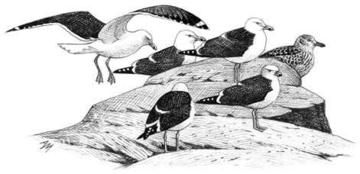
Lesser Black-backed Gull © Andrew Mart
Lesser Black-backed Gulls used to be almost exclusively summer visitors to Britain. Before 1928 Boyd had never seen one in the four winter months, but from then to 1950 he recorded them regularly in November, in December in 14 years, in January in 13 years and in February in ten – sometimes on the ice of the frozen Marbury Mere (Boyd 1951). They have probably adapted to wintering here by being, or becoming, mostly an inland gull, and the sheltered Mersey estuary is unusual in being one of the few places in Britain where substantial numbers have been present on the coast. In the January 1983 national survey, only 13,726 Lesser Black-backed Gulls were recorded at coastal sites, but 10,190 of these were on the Mersey, by far their largest roost in the UK (BTO Winter Atlas). The species’ rise in wintering numbers is shown by the decennial January surveys of gulls roosting inland. In England there were 165 in 1953, 6,960 in 1963, 15,823 in 1973, 36,154 in 1983, 27,230 in 1993 (Burton et al 2003) with a preliminary figure of 43,879 in the 2003/ 04 survey. The Mersey no longer has any special importance, holding only 294 birds on the 2003/ 04 survey date (17 January 2004), with 250 on the same date inland in south Cheshire at Combermere (SJ54X).
The map shows that Lesser Black-backed Gulls spread out widely across the county. They require a large waterbody for a safe overnight roost but otherwise do not need water and more than half (122 out of 218 (56%)) of the tetrads in which they were reported did not have a freshwater or marine (G or H) habitat code. In their feeding and roosting areas, all of the gulls tend to form mixed flocks, but this Atlas shows that this is the large gull most likely to be found on grassland, comprising 74% of their farmland records compared to 65% for Herring Gull. They especially favour slurried fields and flooded stubble, and take invertebrates, seeds and roots. Landfill sites attract some for an easy meal. Many sightings of Lesser Black-backed Gulls are of odd birds or just small groups, with half of all the submitted counts being of five birds or fewer. There were 33 flocks of 100 or more birds, with the maximum of 3,500 on Hoylake shore. Other four-figure flocks were at Arpley tip, loafing on the nearby Mersey (SJ58T/ Y), on Maw Green tip (SJ75E) and the Mersey estuary night-time roost (SJ48J/ P).
The Lesser Black-backed Gulls wintering in the county are of the race graellsii, which breeds in Britain and Iceland and winters along the Atlantic seaboard southward from Britain to west Africa, with most in Iberia. Each winter a few individuals are seen of the darker intermedius race which breed in southern Scandinavia. There has only been one proven record of the nominate race fuscus in England, in 1961. They breed in northern Fennoscandia and migrate south-eastwards to winter in eastern Africa.
Sponsored by Dave Murray

